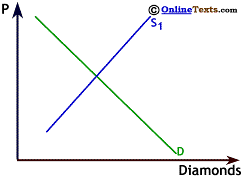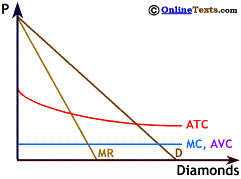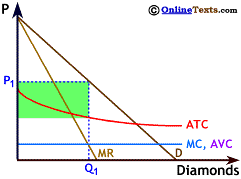

Diamonds are, in fact, very plentiful and were it not for efforts to restrict supply, diamonds would probably be only semi-precious stones. As we show to the right, and as we learned early in Demand and Supply analysis, a shift out in supply causes price to fall and quantity sold to rise. If De Beers did nothing to control supply or maintain its monopoly status, the world-wide supply of diamonds would increase and prices would drop. To the right we show supply increasing from S1, where the supply curve would be with the supply of diamonds carefully controlled, to S2, where the supply might be without control. The result of this increase in supply is that price falls from P1 to P2 and the total quantity of diamonds sold increases from Q1 to Q2. (Note: There are several possible effects that we won't explore, but that are worth keeping in mind. Diamonds may be one of those goods for which both the 'snob' effect and the 'price as an indicator of quality' effect are very important. If so, the fall in price could lead to a reduction in demand, further depressing the price while reducing quantity sold.)

Since De Beers has held a virtual monopoly on the diamond business for the last century, we will use monopoly analysis to understand the changes underway. To the right we show possible Demand (D), Marginal Revenue (MR), Marginal Cost (MC), and Average Total Cost (ATC) curves for De Beers during most of their 100 year history. It may seem odd at first, but it is probably the case that the Marginal Cost of bringing diamonds to market is nearly constant (thus MC = AVC) because, as we noted above, diamonds are quite plentiful on this planet and thus the cost of mining and/or acquiring them probably doesn't increase with quantity in the relevant range.
Like any profit maximizing monopolist, De Beers would operate where MR = MC, producing quantity Q1 at price P1 and earning profits equal to the green area.
Two recent changes have led De Beers to alter its strategy of maintaining a huge stockpile of diamonds, which has in the recent past reached values of over US$5 billion. The first is that De Beers has been criticized for buying diamonds from Angolan Rebels. De Beers fears that these criticisms will hurt its image and lead to a reduction in demand. The second change is the rising cost of maintaining the stockpile of diamonds necessary to restrict supply.

First, we'll examine the possible effect of the criticism that De Beers has been buying diamonds from rebels in Angola and other war zones (called 'conflict diamonds') and thus have helped fund violent conflict in Africa. Such a stigma attached to diamonds will shift back the demand curve for the stones. As shown to the right, this shift back in demand reduces prices from P1 to P2, quantity sold falls from Q1 to Q2 and profits fall as well. The reduced profit after demand falls is shown as the yellow area. These profits are much lower than the profits earned prior to the decrease in demand, shown in gray.
De Beers' new strategy is to reduce its diamond stockpile and to state that it will no longer trade in conflict diamonds. It has also stated that it will not supply diamonds to trading partners who buy stones that originate in war zones. These moves are intended to help stop the reduction in demand that can result from diamonds becoming associated in the minds of potential customers with bloody conflicts in Africa. By reducing its stockpiles it will greatly reduce its fixed costs. The opportunity cost of holding large stockpiles of diamonds is always high and increases as interest rates rise. A reduction of their stockpile from US$5 billion to US$1 billion would reduce opportunity costs by US$400 million a year at 10% and by even more if the next best opportunities had higher rates of return.

First, let's look at the effect of stockpile reduction. As De Beers sells off much of its diamond holdings, reducing the capital tied up in diamonds sitting in vaults in London, its opportunity costs fall. The opportunity cost of maintaining a stockpile of unsold diamonds is a fixed cost because the size of the stockpile probably doesn't vary much with day to day sales of diamonds as the purpose of the stockpile is to keep the world supply of diamonds at a predetermined level. A reduction in fixed costs shifts down the ATC curve to ATC2 but does not affect the marginal cost curve, thus profit maximizing price and quantity remain at P2, Q2. Profits rise due to reduced opportunity costs. This increase is shown as the blue area.

By stating that it will no longer deal in conflict diamonds, De Beers hopes to improve its image and stop any decrease in demand resulting from customer concerns about diamonds originating in war zones. De Beers has stated that it will use some of the proceeds from selling off the stockpile to advertise heavily in order to create "brand recognition" associated with the De Beers brand. Over the last few years, the demand for many luxury goods has been rising quickly (see the article on Mansion Demand). De Beers hopes that its advertising campaign may create the same kind of increase in demand for De Beers branded diamonds. To the right we show the effect of an increase in demand such as De Beers is hoping to create. (Note: Increased advertising increases fixed costs. We don't show this in order to keep the graph less cluttered and focus on the demand shift.)
These changes, particularly the reduction in diamond stockpiles, represent major departures in how De Beers operates, changing a strategy that it has employed for a century. It will be interesting to see if the reduction in stockpiling will depress the price of diamonds or if De Beers can use advertising to successfully increase demand for De Beers brand diamonds enough to offset the effect of greater supply.
Copyright © 1995-2003 OnLineTexts.com, Inc. - All Rights Reserved